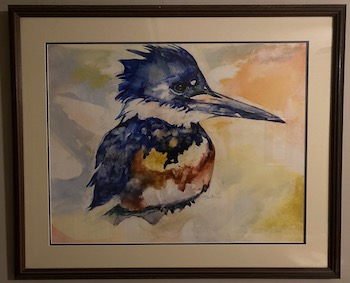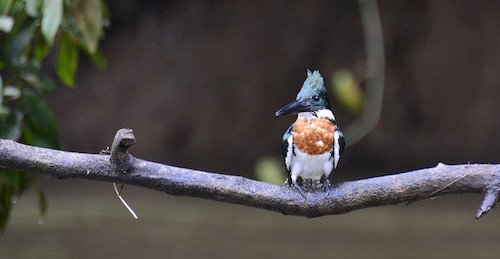
Charles and Bob kick off 2022 with a very unique bird. Hopefully we will inspire you to take a walk by your favorite stream or river to see a kingfisher.
Related episodes: What It’s Like to be a Bird with David Sibley
Our sources for this episode include:
- Fun Facts About Kingfishers
- Ten Things about the Belted Kingfisher
- Aerial Ramming, a Burrow Excavation Behavior by Belted Kingfishers, with a Review of its Occurrence among the Alcedinidae by Hendricks et al., 2013
- The Eastern Belted Kingfisher, Megaceryle Alcyon Alcyon (Linnaeus), in Relation to Fish Management by Salyer and Lagler, 1949
- Attempted predation of a diurnally active Spotted Bat (Euderma maculatum) by a Belted Kingfisher
- Predation of a Western Water Shrew (Sorex navigator) by a Belted Kingfisher (Megaceryle alcyon)
- North American River Otters Followed by Piscivorous Birds, and a River Otter Parental Distraction Display


Hi folks, just finished up the king fisher episode, I was wondering when you mentioned when is their breeding time, and then you mentioned with climate change they have to deal with a dense population, what about the ground? Meaning if they breed in early spring, but we have ever changing climate could the the ground be frozen for longer, and effect their nesting? Especially if they are ramming into the river bank, Im sure they check first to see if it soft, but if 6 inches in it’s hard as a rock.
That is a great point. We will keep our eyes out for research on this.
in comparison, the Australia kookaburra might be the most famous kingfisher, mostly for its insanely comical laughing call, and it is certainly the largest kingfisher species. They nest in cavities too, but they excavate them into the muddy termite nests high up in eucalyptus (gum) trees, yet they also use natural tree cavities and can be lured to nest boxes.
They are using termite nests? That is fascinating. Thanks for sharing this!
I am an avid wildlife photographer who lives in a small town 30 miles north of Detroit. I have devoted the biggest part of the past six years photographing and studying Kingfishers. Granted lakeside access from a nearby waterfront homeowner, I have watched from an enclosed blind for these six years and have countless video and still photographs of them. In particular, I have lots of video of them catching and eating fish and slapping them silly against the wooden perch that they sit on. I would be happy to share photographs or video clips of them with your listeners. I am an active Facebook user who posts these images under my account name Rob Weir.
Wow! What a opportunity to study Kingfishers. If you would like to send a link to your photos and videos that would be great.
Thanks for this wonderful podcast on Kingfishers. I see one every few weeks on a power line that parallels a local marsh. I can see the bird sitting on the wire and looking toward the water when I drive by in the car. It is usually in the middle of the day when I drive by. The next time I see one I’m going to stop nearby and with my binoculars see if I can spot a nest in the marsh mud. It always makes my day to see this little bird with the big beak – and big attitude.
“Little bird with the big beak- and big attitude” What a great way to describe the Kingfisher!
Thank you for the episode on the kingfisher! I live on a small pond in Virginia and just this past fall noticed a different chirping bird I had never heard before. Was fascinated to find it was the kingfisher. Two weeks ago we had a small portion ice free in our cove and I could still see and hear him. Now with this cold snap, all water is iced over. Any predictions as to if it will return on ice out?
Glad you had a kingfisher! No predictions but fingers crossed that it returns.